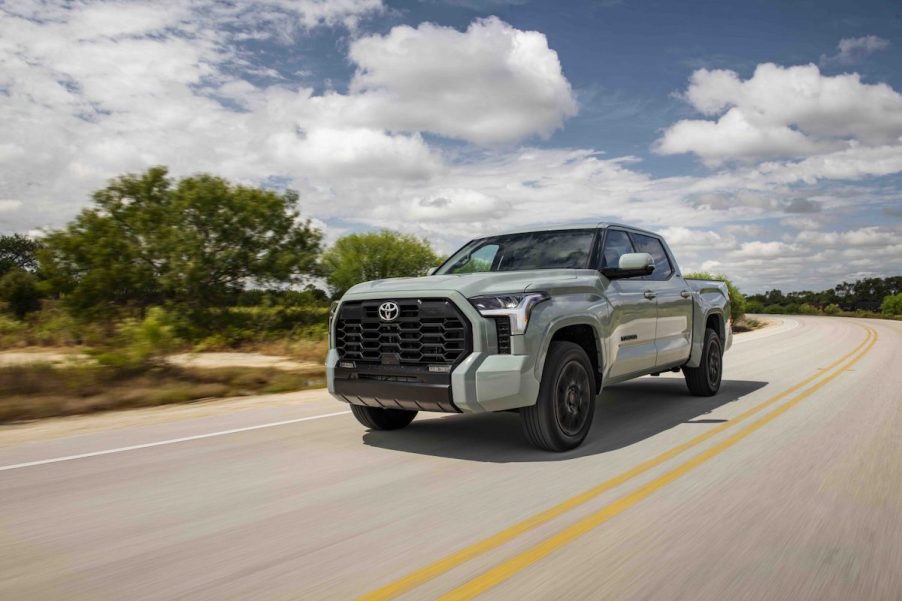
Toyota Tundra Hybrid and the Ford F-150 Hybrid: Which One Gets the Best Real-World Fuel Economy
A vehicle’s real-world fuel economy can differ no matter what is on the sticker. And before you make it the deciding factor in your choice between two similar vehicles, it’s essential to know the difference between their advertised and actual fuel economy. This is especially true of hybrids, a prime selling factor of which is their superior fuel efficiency compared to their gas-powered counterparts. When you consider two vehicles like the 2022 Toyota Tundra Hybrid and the 2021 Ford F-150 Hybrid, the difference between advertised and actual does make a difference.
What’s the difference between advertised and real-world fuel economy?
The fuel economy numbers you see advertised for a vehicle are U.S. Environmental Protection Agency (EPA) estimates. This government agency puts a lot of time and effort into arriving at those estimates. However, these estimates are just that. The EPA includes a disclaimer that mileage can vary depending on certain conditions.
What are these conditions? Well, the EPA tests vehicles in optimal conditions. Yours may not be, depending on how well you maintain it. They also observe best practices when driving, which, at points, you may not. Think about how many times you’ve hit 75, 80, or even 90 miles an hour in the left lane down a free stretch of highway.

While the EPA tries to replicate stop-and-go traffic commonly found in cities, its estimates are often too low. Replicating driving conditions when construction reduces a divided highway to one lane or a car is totaled on a narrow street can be difficult.
When you add in other variables like inclement weather, you can wind up with actual fuel economy numbers far from what’s been advertised.
Which truck has the better fuel economy: the Toyota Tundra Hybrid or Ford F-150 Hybrid?
Automotive publications like Car and Driver and Cars.com conduct their own fuel economy tests to determine whether the EPA numbers are accurate. Each publication approaches these tests slightly differently. In a recent Cars.com piece, testers evaluated the 2022 Toyota Tundra Hybrid and the 2021 Ford F-150 Hybrid by driving them down a 200-mile stretch that included suburban and rural roads and highways.
This test didn’t involve much stop-and-go traffic. And testers tried to account for other variables by using RWD, and minimal air conditioning, among different approaches. Their test found that the Tundra Hybrid had achieved a combined mpg of 21.8 mpg, while the F-150 had attained a combined mpg of 25.9 mpg, according to each vehicle’s onboard computer.
In both cases, the test result exceeded the EPA estimates. The F-150 hybrid is rated for 24 mpg, while the Tundra Hybrid’s is rated for 20 mpg. Testers also manually calculated the fuel economy numbers using the amount of gas actually consumed and found that the F-150 Hybrid and Tundra Hybrid’s numbers were 25.5 mpg and 24.1 mpg, respectively.
A look at the Tundra and Ford F-150 Hybrids
Based on these test results, you may get better fuel economy numbers from these vehicles than advertised. It is worth noting, however, that the test, as described, did not involve a lot (or any) urban areas. So, your combined mpg may be lower if you commute a lot through the cities.
Still, both provide respectable fuel economy numbers. And though the Tundra Hybrid’s mpg comes in lower, it still has a lot going for it. It’s a bit more powerful than the F-150 Hybrid, with a twin-turbocharged V-6 engine and electric motor system that produce 437 hp and 583 lb-ft of torque. It comes with two cab and two bed options, and a standard 8.0-inch touch screen (14.0-inch on higher trims), among other interior amenities.
The F-150 Hybrid also uses a twin-turbocharged V-6 engine and electric motor system that generate 430 hp and 570 lb-ft of torque. It’s also distinguished by a well-designed interior, an 8.0-inch touchscreen (12.0-inch on higher-level trims), and plenty of cargo space and cab room. There are three cab and three bed options and multiple non-hybrid powertrains, all of which helped the 2021 Ford F-150 earn Cars.com’s Best of 2021 award in its category.


